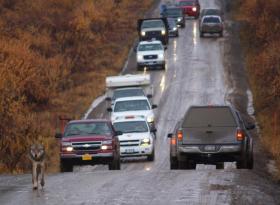Wolf Advocates say Lack of Denali Buffer has Economic Consequences
kuac.org
In 2010, Alaska's Board of Game eliminated a buffer along the northeastern boundary of Denali National Park and Preserve. The buffer was set up to protect Park wolves that wandered across the boundary into state land, where hunting and trapping is legal. Before 2010, National Park Service data show that 45 percent of visitors who traveled to the Eielson Visitor center in Denali successfully caught sight of a wolf. But this year, Park Service Wildlife Biologist Bridget Borg says wolf sightings have declined. "The probability of a west bound trip to Eielson or further and seeing a wolf in 2012 was estimated at 12 percent," says Borg.
Kirk Hoessle is the President of Alaska Wildland Adventures. His company leads small group nature tours throughout the state. He says wildlife viewing is a major draw for his clients. "For the most part people have a wide variety of interests and they don't really have any targeted species," he says. "However there are some that have very specific animals they want to see and then our job is to in the sale end of things is to be realistic as to what their chances of seeing those wildlife are."
Wolves are notoriously elusive. Park Service employees survey for wildlife throughout the year, but for guides like Kirk Hoessle, who don't spend entire seasons in the park, sightings are more rare. Hoessle says he's been on the park road hundreds of times in three decades and he can count the number of times he's seen wolves on both hands. "It's hard to tell whether that's a result of getting lucky, or whether it's a result of less wolves in the park," says Hoessle.
Denali Park Wolves
One wolf pack in the park had a reputation for its visibility. But this past spring the Park Service announced that the Grant Creek Pack has dispersed. The announcement drastically changed Diane Bentivegna's summer travel plans. "This was our maiden voyage so to speak," says Bentivegna.
Bentivegna is the Education Director at the National Wolf Watcher Coalition, a non-profit wolf advocacy group, based in New York State. She was working with Kirk Hoessle and Alaska Wildland Adventures to plan a guided wolf watching trip in Denali for up to 20 people next summer. "This would have been a regular experience of ours probably two to three times a year from here on in, however the outlook is so bleak at this point, that we're planning another similar trip with another state," she says.
Wildlife advocates argue that a decline in Denali's wolf population could have a serious impact on ecotourism and Alaska's economy. According to a report from the Anchorage and Juneau based McDowell Group, wildlife viewing was the second most popular activity for tourists visiting Alaska in 2011. The report also indicates that spotting wild animals was the number one activity for visitors to interior Alaska. Those who traveled to Denali were more likely to look for wildlife.
If Bentivegna had followed through with her plans, she says a group of at least 20 visitors could have brought at least $170 thousand dollars to the state. "We'd be paying for food, lodging transportation, guide fees, public land use fees, equipment rentals and related kinds of things like binoculars, cameras and special lenses and field guides, maps and backpacking equipment," she says. "It is a trip that requires substantial financial investment."
Groups including the Alaska Wildlife Alliance pointed to the economic benefits of wolf watching when they petitioned the Alaska Board of Game three times this summer to reestablish the buffer zone along the park boundary. Conservation biologist Rick Steiner authored the petitions. "There's 400-thousand people in Denali each year," says Steiner. "Financial estimates show Denali tourism contributes over a140 million dollars a year to Alaska's economy so by giving a little bit of a buffer on the eastern edge of the park, the state would be enhancing that economic."
The board denied all three petitions as well as an emergency order request. Acting Board of Game Chairman Ted Spraker says there is no scientific evidence that points to a serious decline in the wolf population. He says the Board considers economic benefits in their decision making process.
"We understand those facts about eh costs of the wolf and what it provides to a trapper and what it provides to people that look at it," says Spraker. "The Board looks at all those different issues."
Guide Kirk Hoessle says he can't put a dollar value on a wolf sighting. But as the disagreement between wildlife advocates, the state and the National Park Service becomes increasingly more complicated, he says it's more likely his business could get caught in the crossfire. "There are some groups that are very passionate about protecting wolves and in the end, their actions may reduce the amount of people who were willing to come to Alaska," says Hoessle. "And if that's the case, they're only gonna hurt the small businesses because those are the one of us who attract nature lovers and give nature lover's what they want to see and if a great deal is made of this event, they're the kind of visitors that will say 'Well, I'll go somewhere else this year."
The same groups who petitioned the Board of Game this year have requested a second emergency order from Fish and Game Commissioner Cora Campbell. They say they may approach the state legislature next spring. They've also made mention of working with the federal Department of the Interior to address wolf protections in and around Denali












No comments:
Post a Comment